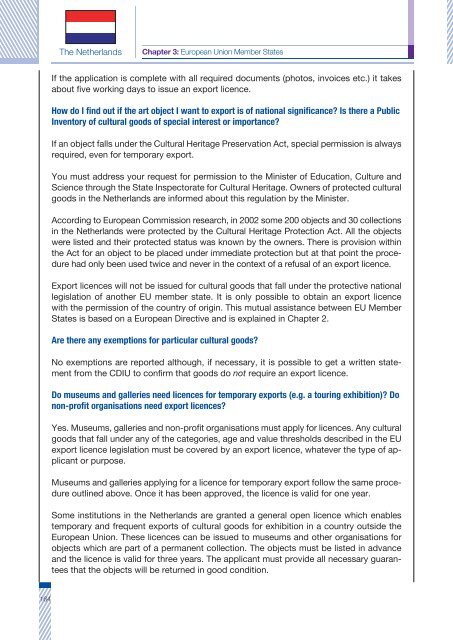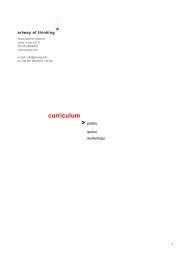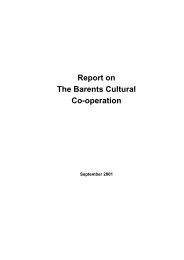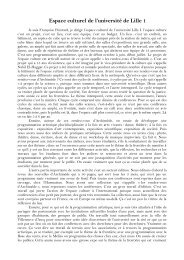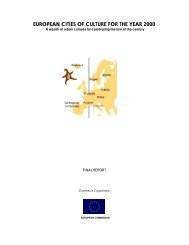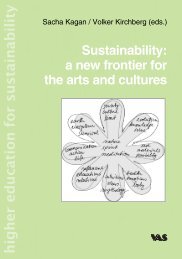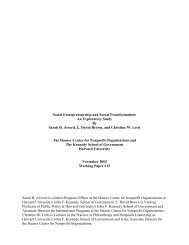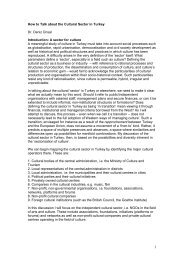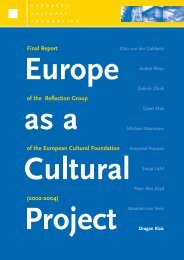A guide to the export and import of cultural goods between Russia ...
A guide to the export and import of cultural goods between Russia ...
A guide to the export and import of cultural goods between Russia ...
Create successful ePaper yourself
Turn your PDF publications into a flip-book with our unique Google optimized e-Paper software.
The Ne<strong>the</strong>rl<strong>and</strong>s<br />
Chapter 3: European Union Member States<br />
If <strong>the</strong> application is complete with all required documents (pho<strong>to</strong>s, invoices etc.) it takes<br />
about five working days <strong>to</strong> issue an <strong>export</strong> licence.<br />
How do I find out if <strong>the</strong> art object I want <strong>to</strong> <strong>export</strong> is <strong>of</strong> national significance? Is <strong>the</strong>re a Public<br />
Inven<strong>to</strong>ry <strong>of</strong> <strong>cultural</strong> <strong>goods</strong> <strong>of</strong> special interest or <strong>import</strong>ance?<br />
If an object falls under <strong>the</strong> Cultural Heritage Preservation Act, special permission is always<br />
required, even for temporary <strong>export</strong>.<br />
You must address your request for permission <strong>to</strong> <strong>the</strong> Minister <strong>of</strong> Education, Culture <strong>and</strong><br />
Science through <strong>the</strong> State Inspec<strong>to</strong>rate for Cultural Heritage. Owners <strong>of</strong> protected <strong>cultural</strong><br />
<strong>goods</strong> in <strong>the</strong> Ne<strong>the</strong>rl<strong>and</strong>s are informed about this regulation by <strong>the</strong> Minister.<br />
According <strong>to</strong> European Commission research, in 2002 some 200 objects <strong>and</strong> 30 collections<br />
in <strong>the</strong> Ne<strong>the</strong>rl<strong>and</strong>s were protected by <strong>the</strong> Cultural Heritage Protection Act. All <strong>the</strong> objects<br />
were listed <strong>and</strong> <strong>the</strong>ir protected status was known by <strong>the</strong> owners. There is provision within<br />
<strong>the</strong> Act for an object <strong>to</strong> be placed under immediate protection but at that point <strong>the</strong> procedure<br />
had only been used twice <strong>and</strong> never in <strong>the</strong> context <strong>of</strong> a refusal <strong>of</strong> an <strong>export</strong> licence.<br />
Export licences will not be issued for <strong>cultural</strong> <strong>goods</strong> that fall under <strong>the</strong> protective national<br />
legislation <strong>of</strong> ano<strong>the</strong>r EU member state. It is only possible <strong>to</strong> obtain an <strong>export</strong> licence<br />
with <strong>the</strong> permission <strong>of</strong> <strong>the</strong> country <strong>of</strong> origin. This mutual assistance <strong>between</strong> EU Member<br />
States is based on a European Directive <strong>and</strong> is explained in Chapter 2.<br />
Are <strong>the</strong>re any exemptions for particular <strong>cultural</strong> <strong>goods</strong>?<br />
No exemptions are reported although, if necessary, it is possible <strong>to</strong> get a written statement<br />
from <strong>the</strong> CDIU <strong>to</strong> confirm that <strong>goods</strong> do not require an <strong>export</strong> licence.<br />
Do museums <strong>and</strong> galleries need licences for temporary <strong>export</strong>s (e.g. a <strong>to</strong>uring exhibition)? Do<br />
non-pr<strong>of</strong>it organisations need <strong>export</strong> licences?<br />
Yes. Museums, galleries <strong>and</strong> non-pr<strong>of</strong>it organisations must apply for licences. Any <strong>cultural</strong><br />
<strong>goods</strong> that fall under any <strong>of</strong> <strong>the</strong> categories, age <strong>and</strong> value thresholds described in <strong>the</strong> EU<br />
<strong>export</strong> licence legislation must be covered by an <strong>export</strong> licence, whatever <strong>the</strong> type <strong>of</strong> applicant<br />
or purpose.<br />
Museums <strong>and</strong> galleries applying for a licence for temporary <strong>export</strong> follow <strong>the</strong> same procedure<br />
outlined above. Once it has been approved, <strong>the</strong> licence is valid for one year.<br />
Some institutions in <strong>the</strong> Ne<strong>the</strong>rl<strong>and</strong>s are granted a general open licence which enables<br />
temporary <strong>and</strong> frequent <strong>export</strong>s <strong>of</strong> <strong>cultural</strong> <strong>goods</strong> for exhibition in a country outside <strong>the</strong><br />
European Union. These licences can be issued <strong>to</strong> museums <strong>and</strong> o<strong>the</strong>r organisations for<br />
objects which are part <strong>of</strong> a permanent collection. The objects must be listed in advance<br />
<strong>and</strong> <strong>the</strong> licence is valid for three years. The applicant must provide all necessary guarantees<br />
that <strong>the</strong> objects will be returned in good condition.<br />
164


